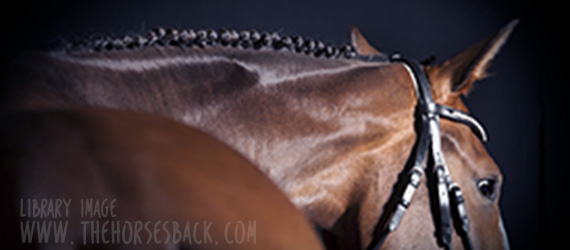
“I went through three years of horror…”
So speaks a Warmblood owner, reflecting upon a truly dreadful period in her life. Like many other owners, she has gained belated understanding of her horse’s problems after reading about research findings into the C6-C7 malformation (article) led by Australian gross anatomist, Sharon May-Davis.
Sadly, this is a bittersweet moment: there is a temporary relief as everything finally makes sense, yet with it comes the realisation that there is nothing that can be, or could have been, done for a treasured horse bearing the more extreme version of this malformation.
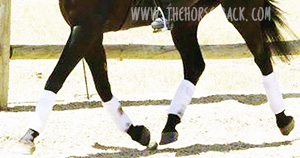 Here, Diana from Michigan, USA, gives her story of the desperation and – ultimately – heartache she experienced when trying to find out what was wrong with her horse of a lifetime, a young Oldenburg gelding, “the kindest horse I ever had”.
Here, Diana from Michigan, USA, gives her story of the desperation and – ultimately – heartache she experienced when trying to find out what was wrong with her horse of a lifetime, a young Oldenburg gelding, “the kindest horse I ever had”.
Note: We are not identifying the lines of the individual horse in this story. If you’re thinking we should, perhaps remember that it’s a litigious world out there.
But for now, over to Diana.
© All text copyright of Jane Clothier, www.thehorsesback.com. No reproduction of partial or entire text without permission. Sharing the link back to this page is fine. Please contact me for more information. Thank you!
Diana’s Story
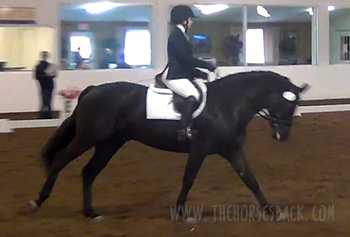 I purchased a stunning 3-year-old Oldenburg to fulfill my dream of developing a young horse through the upper levels in dressage. I cashed in the 401K [retirement savings plan] for the horse and bought a Schleese saddle.
I purchased a stunning 3-year-old Oldenburg to fulfill my dream of developing a young horse through the upper levels in dressage. I cashed in the 401K [retirement savings plan] for the horse and bought a Schleese saddle.
For the first two years (ages 3 and 4) we were champion every time out.
At age 5, however, my trainer noticed he began to drag his left hind toe. Then his impulsion began to deteriorate, and months later he became too unstable to safely handle. He was euthanized at 7 years old.
Looking back, I now believe that all his quirks were directly related to this problem. I am going to briefly list the oddities I experienced with this wonderful horse.
I am not a vet or tech, and am only sharing my experiences in the event that it may help someone else, because my journey was one of the most emotionally draining experiences in my life.
Possible Signs of this Warmblood’s C6-C7 Problem
I purchased my gelding on his 3rd birthday and he’d had 30 days under saddle. The oddities of my gelding: he was extremely sweet and willing – the kindest horse I ever had.
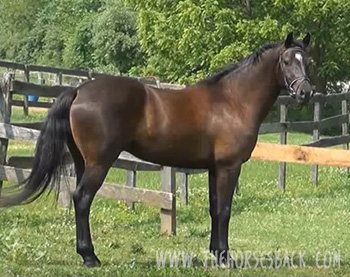 He required a tremendous amount of leg every step. Although there seemed to be no ‘self-carriage’, I attributed this to his being green and still learning.
He required a tremendous amount of leg every step. Although there seemed to be no ‘self-carriage’, I attributed this to his being green and still learning.
He would buck EVERY TIME he was saddled (I was very conscientious about slowly tightening the girth, tried every type of girth, pads, had adjustable saddle, etc).
Again, I attributed the bucking to youthfulness, and would let him buck out for a few laps, and then wondered if I had created a habit, because this occurred every schooling.
- If he wasn’t lunged first, he would explode into a non-rideable rodeo with absolutely no warning.
- He had a very difficult time bending to the left – he would try, but would drift.
- Two separate times after mounting at the block, he felt like he arched or sucked his back up about 3 inches before walking off.
- After 25 mins of schooling he would start rooting at the reins, or if the lesson was a short one, as soon as I’d give him his head to cool out.
- He was a stumbler – not often – again, I attributed it to youth.
- He could not be shod or trimmed without being sedated.
- Once, a friend said it looked like he couldn’t put his head down to reach hay. Of course, I thought she was nuts until I witnessed it first hand.
Questions, thoughts or comments? Join us at The Horse’s Back Facebook Group.
Investigating the C6-C7 Problem
During my discovery phase, he was diagnosed with moderate PSSM. So, he and I spent 9 months testing sugar levels in hay, with turnout in a dry lot.
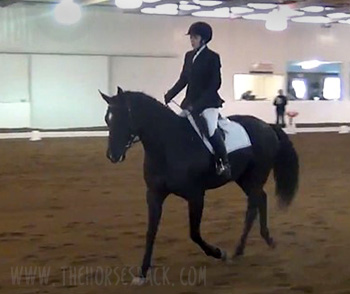 There were periods he would barely walk forward when leading, and at the time I thought he was tying up, but it didn’t seem like what I had read, and I have never witnessed a horse tying up.
There were periods he would barely walk forward when leading, and at the time I thought he was tying up, but it didn’t seem like what I had read, and I have never witnessed a horse tying up.
Then in his latter days, his neurological issues became more obvious with each passing day.
I did have a myelogram done on him, and it revealed compression of the spinal cord at C3 and C4.
Vets at Michigan State University did finally identify malformations of both C6 and C7 through radiographs. Their report stated:
The intervertebral foramen is severely reduced at C6-C7. A minimal amount of osseous proliferation is noted along the dorsal aspect of the articular processes at C5-C6.
Interpretation: Multifocal cervical articular degenerative joint disease (C4-T1), most severe at C6-7.”
I had a very difficult time with the decision to euthanize him, because his neurological issues would fluctuate. Some days, no evidence all. On other days, he would fall against the stall wall when turning him around in the stall.
In any event, I euthanized him, believing that he was experiencing severe pain from the narrowed foramen at C6 and C7.
I believe they were the reasons for the bucking, for needing to be sedated for the farrier, for not being able to lower his head, for rooting on the reins, for barely walking forward when I thought he was tying up, and the bizarre lifting of his back. He also had a very difficult time holding his right lead, and would swap unless you really held him.
I am so, so glad I ran across this website and article because I will go to sleep tonight knowing that euthanizing was for sure the right thing to do. Thank you!
Diana
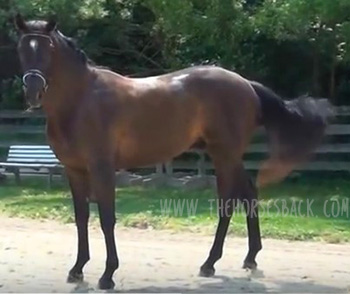
If you’re about to purchase a horse that falls into the ‘at risk’ category for this malformation, do your due diligence as a buyer, and have the caudal cervical vertebrae radiographed as part of your pre-purchase examination. A protocol for radiographing for the malformation is on this site.
The following papers also cover radiographs and CT imaging of the C6 malformation:
Ex Vivo Computated Tomographic Evaluation of Morphology Variations in Equine Cervical Vertebrae, Veraa, S. et al, Veterinary Radiology & Ultrasound, Vol. 57, Issue 5
Prevalence of Anatomical Variation of the Sixth Cervical Vertebra and Association with Vertebral Canal Stenosis and Articular Process Arthritis in the Horse,
Spriet, M. and M Aleman, Veterinary Radiology & Ultrasound, Vol. 57, Issue 3
If you wish to comment, please feel free to do so below, but please do so with respect for an owner who found herself in a nightmare situation. Alternatively, come over the blog’s discussion group on Facebook.
